MBA402 Governance, Ethics: Timberwall Constructions Sustainability
VerifiedAdded on 2023/06/04
|13
|3109
|363
Report
AI Summary
This report provides a sustainability assessment of Timberwall Constructions based on the GRI (Global Reporting Initiative) Sustainability Reporting Standards. It examines economic sustainability, focusing on financial implications of climate change, corruption mitigation, and legal actions related to anti-competitive practices. The assessment of environmental sustainability covers energy consumption, impacts on biodiversity, and compliance with environmental laws. Social sustainability is evaluated through recruitment and termination practices, and actions related to discrimination and social cohesion. The report uses specific GRI disclosures to analyze Timberwall Constructions' practices and identify areas for improvement in alignment with sustainability principles. This detailed analysis highlights the importance of sustainable business practices and provides insights into how Timberwall Constructions can enhance its performance across various dimensions of sustainability.
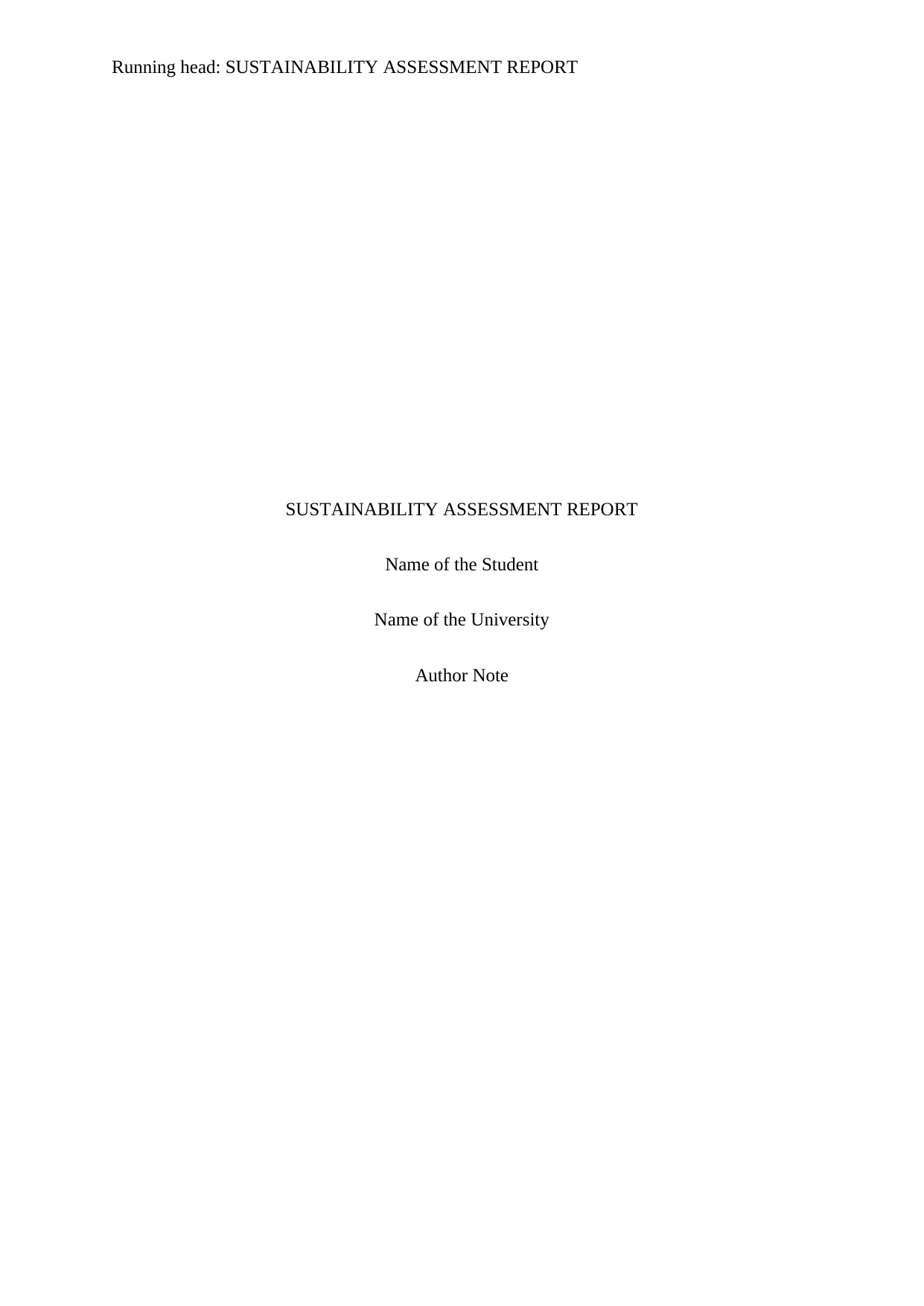
Running head: SUSTAINABILITY ASSESSMENT REPORT
SUSTAINABILITY ASSESSMENT REPORT
Name of the Student
Name of the University
Author Note
SUSTAINABILITY ASSESSMENT REPORT
Name of the Student
Name of the University
Author Note
Paraphrase This Document
Need a fresh take? Get an instant paraphrase of this document with our AI Paraphraser
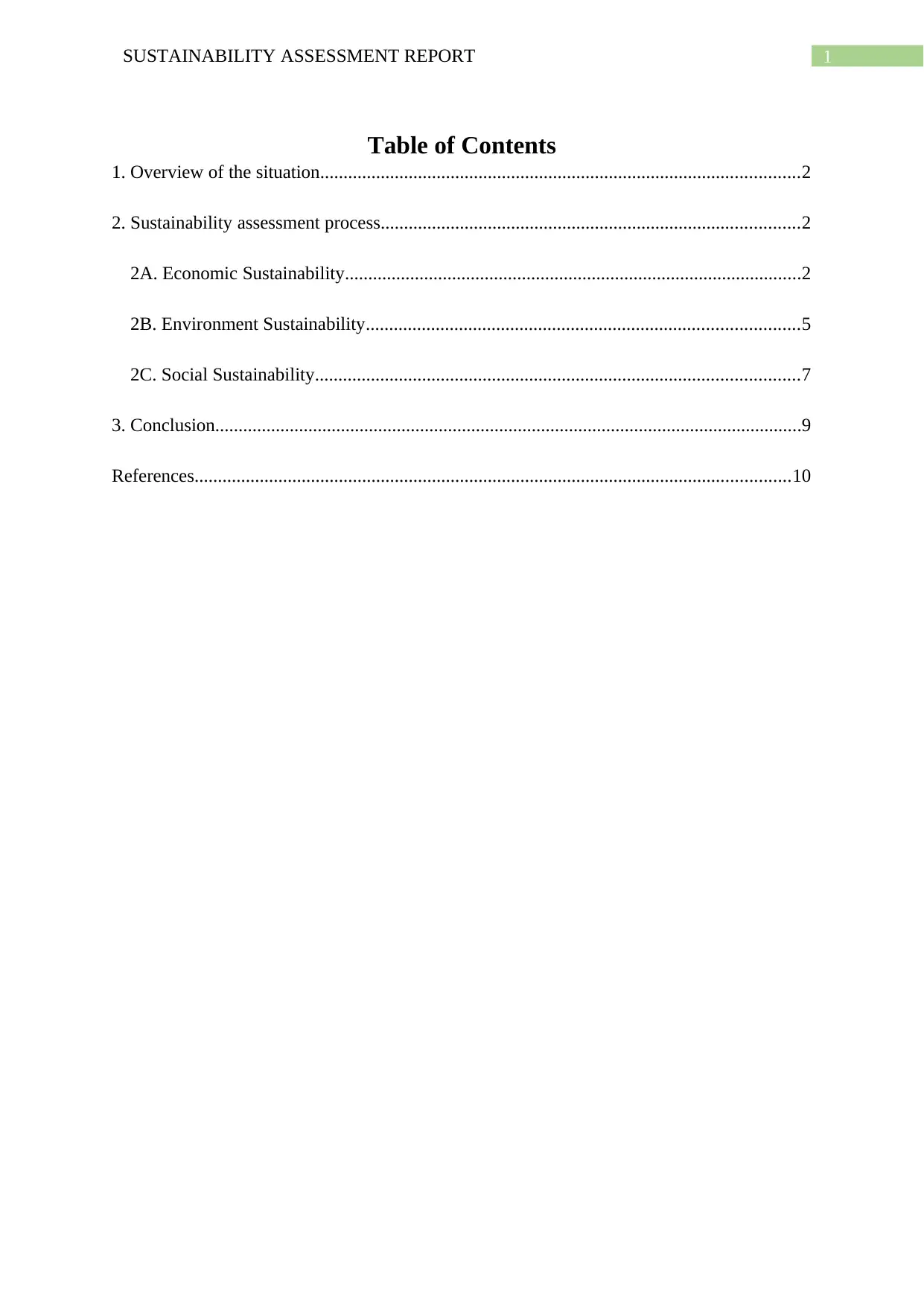
1SUSTAINABILITY ASSESSMENT REPORT
Table of Contents
1. Overview of the situation.......................................................................................................2
2. Sustainability assessment process..........................................................................................2
2A. Economic Sustainability..................................................................................................2
2B. Environment Sustainability.............................................................................................5
2C. Social Sustainability........................................................................................................7
3. Conclusion..............................................................................................................................9
References................................................................................................................................10
Table of Contents
1. Overview of the situation.......................................................................................................2
2. Sustainability assessment process..........................................................................................2
2A. Economic Sustainability..................................................................................................2
2B. Environment Sustainability.............................................................................................5
2C. Social Sustainability........................................................................................................7
3. Conclusion..............................................................................................................................9
References................................................................................................................................10
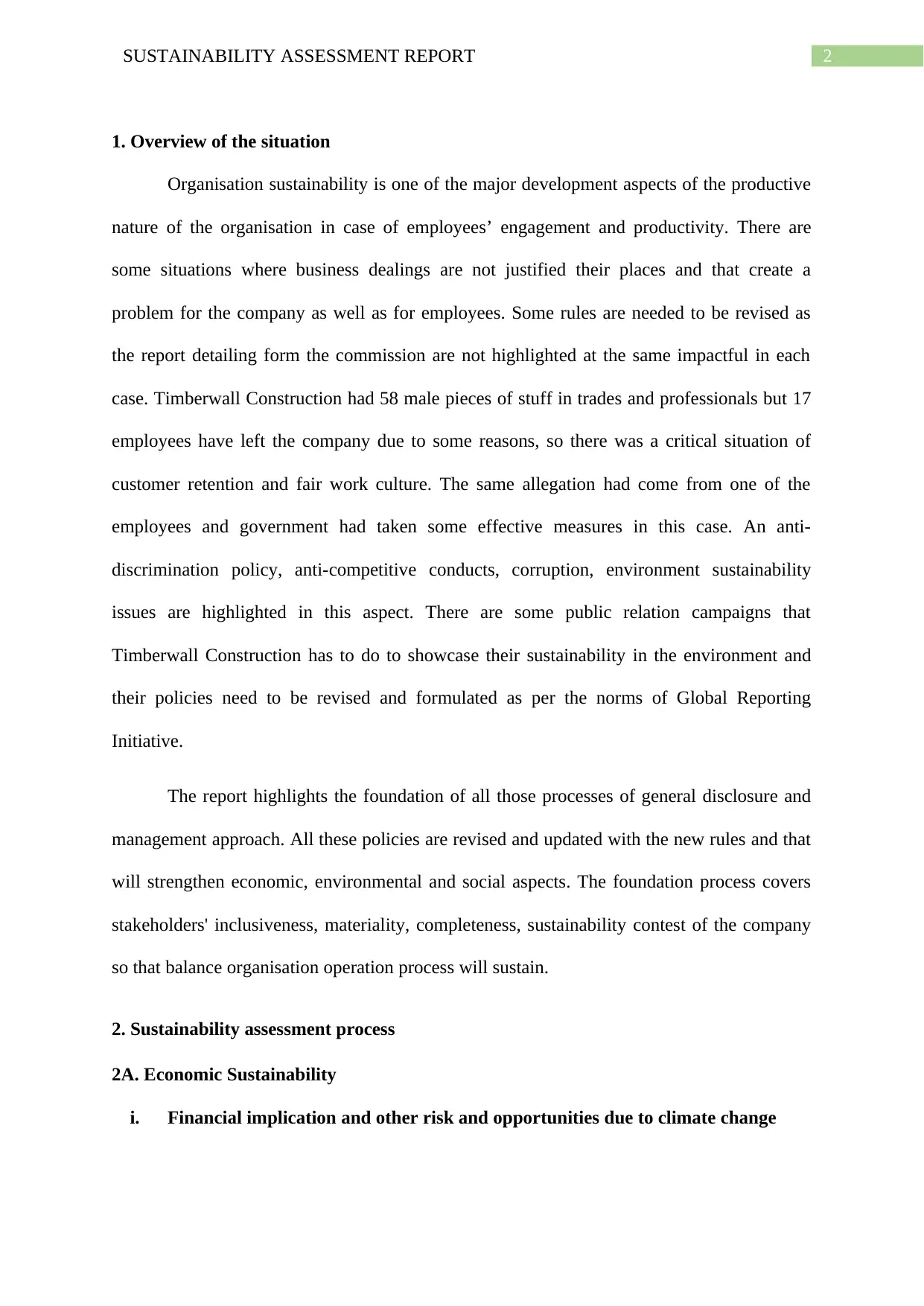
2SUSTAINABILITY ASSESSMENT REPORT
1. Overview of the situation
Organisation sustainability is one of the major development aspects of the productive
nature of the organisation in case of employees’ engagement and productivity. There are
some situations where business dealings are not justified their places and that create a
problem for the company as well as for employees. Some rules are needed to be revised as
the report detailing form the commission are not highlighted at the same impactful in each
case. Timberwall Construction had 58 male pieces of stuff in trades and professionals but 17
employees have left the company due to some reasons, so there was a critical situation of
customer retention and fair work culture. The same allegation had come from one of the
employees and government had taken some effective measures in this case. An anti-
discrimination policy, anti-competitive conducts, corruption, environment sustainability
issues are highlighted in this aspect. There are some public relation campaigns that
Timberwall Construction has to do to showcase their sustainability in the environment and
their policies need to be revised and formulated as per the norms of Global Reporting
Initiative.
The report highlights the foundation of all those processes of general disclosure and
management approach. All these policies are revised and updated with the new rules and that
will strengthen economic, environmental and social aspects. The foundation process covers
stakeholders' inclusiveness, materiality, completeness, sustainability contest of the company
so that balance organisation operation process will sustain.
2. Sustainability assessment process
2A. Economic Sustainability
i. Financial implication and other risk and opportunities due to climate change
1. Overview of the situation
Organisation sustainability is one of the major development aspects of the productive
nature of the organisation in case of employees’ engagement and productivity. There are
some situations where business dealings are not justified their places and that create a
problem for the company as well as for employees. Some rules are needed to be revised as
the report detailing form the commission are not highlighted at the same impactful in each
case. Timberwall Construction had 58 male pieces of stuff in trades and professionals but 17
employees have left the company due to some reasons, so there was a critical situation of
customer retention and fair work culture. The same allegation had come from one of the
employees and government had taken some effective measures in this case. An anti-
discrimination policy, anti-competitive conducts, corruption, environment sustainability
issues are highlighted in this aspect. There are some public relation campaigns that
Timberwall Construction has to do to showcase their sustainability in the environment and
their policies need to be revised and formulated as per the norms of Global Reporting
Initiative.
The report highlights the foundation of all those processes of general disclosure and
management approach. All these policies are revised and updated with the new rules and that
will strengthen economic, environmental and social aspects. The foundation process covers
stakeholders' inclusiveness, materiality, completeness, sustainability contest of the company
so that balance organisation operation process will sustain.
2. Sustainability assessment process
2A. Economic Sustainability
i. Financial implication and other risk and opportunities due to climate change
⊘ This is a preview!⊘
Do you want full access?
Subscribe today to unlock all pages.

Trusted by 1+ million students worldwide
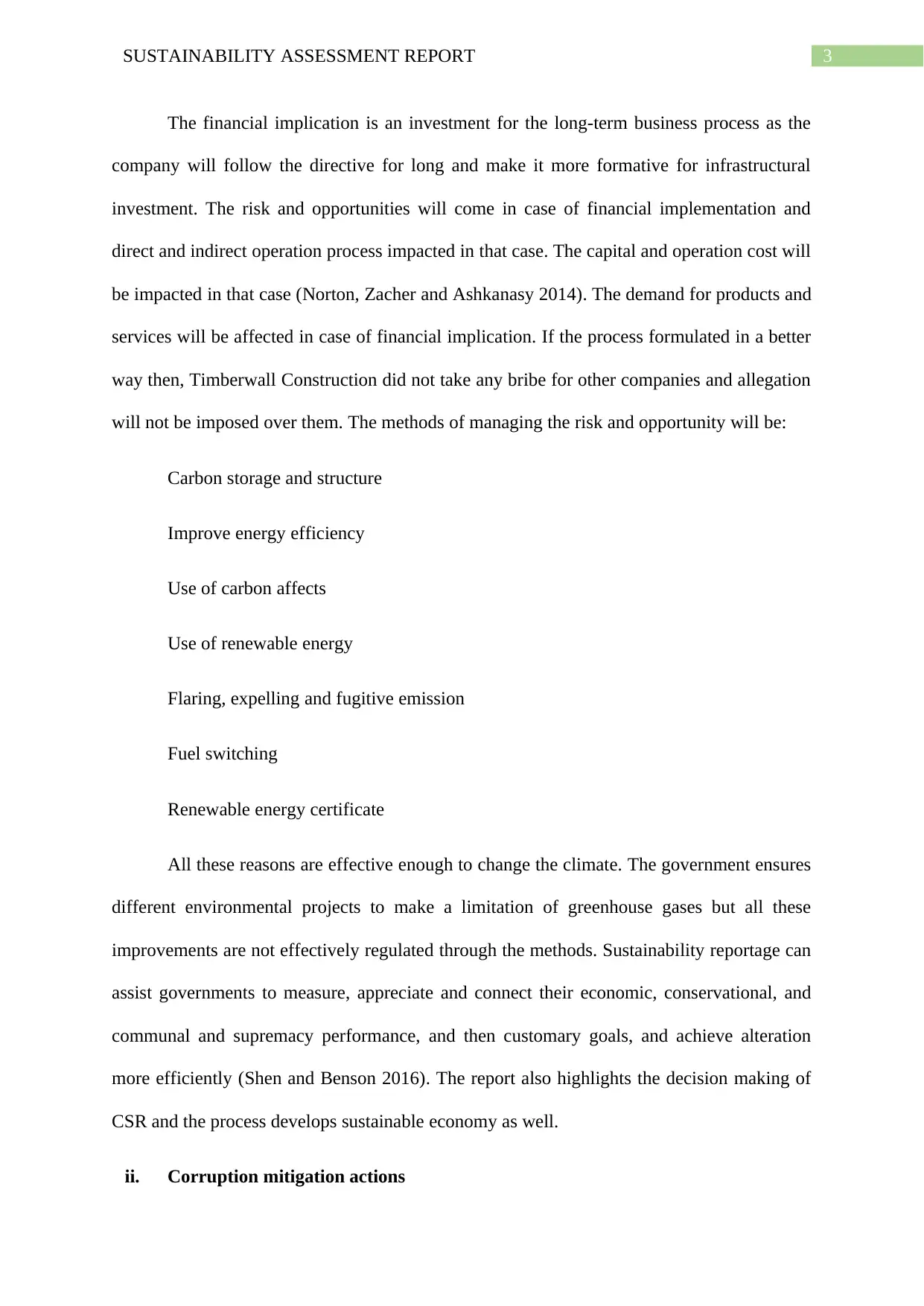
3SUSTAINABILITY ASSESSMENT REPORT
The financial implication is an investment for the long-term business process as the
company will follow the directive for long and make it more formative for infrastructural
investment. The risk and opportunities will come in case of financial implementation and
direct and indirect operation process impacted in that case. The capital and operation cost will
be impacted in that case (Norton, Zacher and Ashkanasy 2014). The demand for products and
services will be affected in case of financial implication. If the process formulated in a better
way then, Timberwall Construction did not take any bribe for other companies and allegation
will not be imposed over them. The methods of managing the risk and opportunity will be:
Carbon storage and structure
Improve energy efficiency
Use of carbon affects
Use of renewable energy
Flaring, expelling and fugitive emission
Fuel switching
Renewable energy certificate
All these reasons are effective enough to change the climate. The government ensures
different environmental projects to make a limitation of greenhouse gases but all these
improvements are not effectively regulated through the methods. Sustainability reportage can
assist governments to measure, appreciate and connect their economic, conservational, and
communal and supremacy performance, and then customary goals, and achieve alteration
more efficiently (Shen and Benson 2016). The report also highlights the decision making of
CSR and the process develops sustainable economy as well.
ii. Corruption mitigation actions
The financial implication is an investment for the long-term business process as the
company will follow the directive for long and make it more formative for infrastructural
investment. The risk and opportunities will come in case of financial implementation and
direct and indirect operation process impacted in that case. The capital and operation cost will
be impacted in that case (Norton, Zacher and Ashkanasy 2014). The demand for products and
services will be affected in case of financial implication. If the process formulated in a better
way then, Timberwall Construction did not take any bribe for other companies and allegation
will not be imposed over them. The methods of managing the risk and opportunity will be:
Carbon storage and structure
Improve energy efficiency
Use of carbon affects
Use of renewable energy
Flaring, expelling and fugitive emission
Fuel switching
Renewable energy certificate
All these reasons are effective enough to change the climate. The government ensures
different environmental projects to make a limitation of greenhouse gases but all these
improvements are not effectively regulated through the methods. Sustainability reportage can
assist governments to measure, appreciate and connect their economic, conservational, and
communal and supremacy performance, and then customary goals, and achieve alteration
more efficiently (Shen and Benson 2016). The report also highlights the decision making of
CSR and the process develops sustainable economy as well.
ii. Corruption mitigation actions
Paraphrase This Document
Need a fresh take? Get an instant paraphrase of this document with our AI Paraphraser
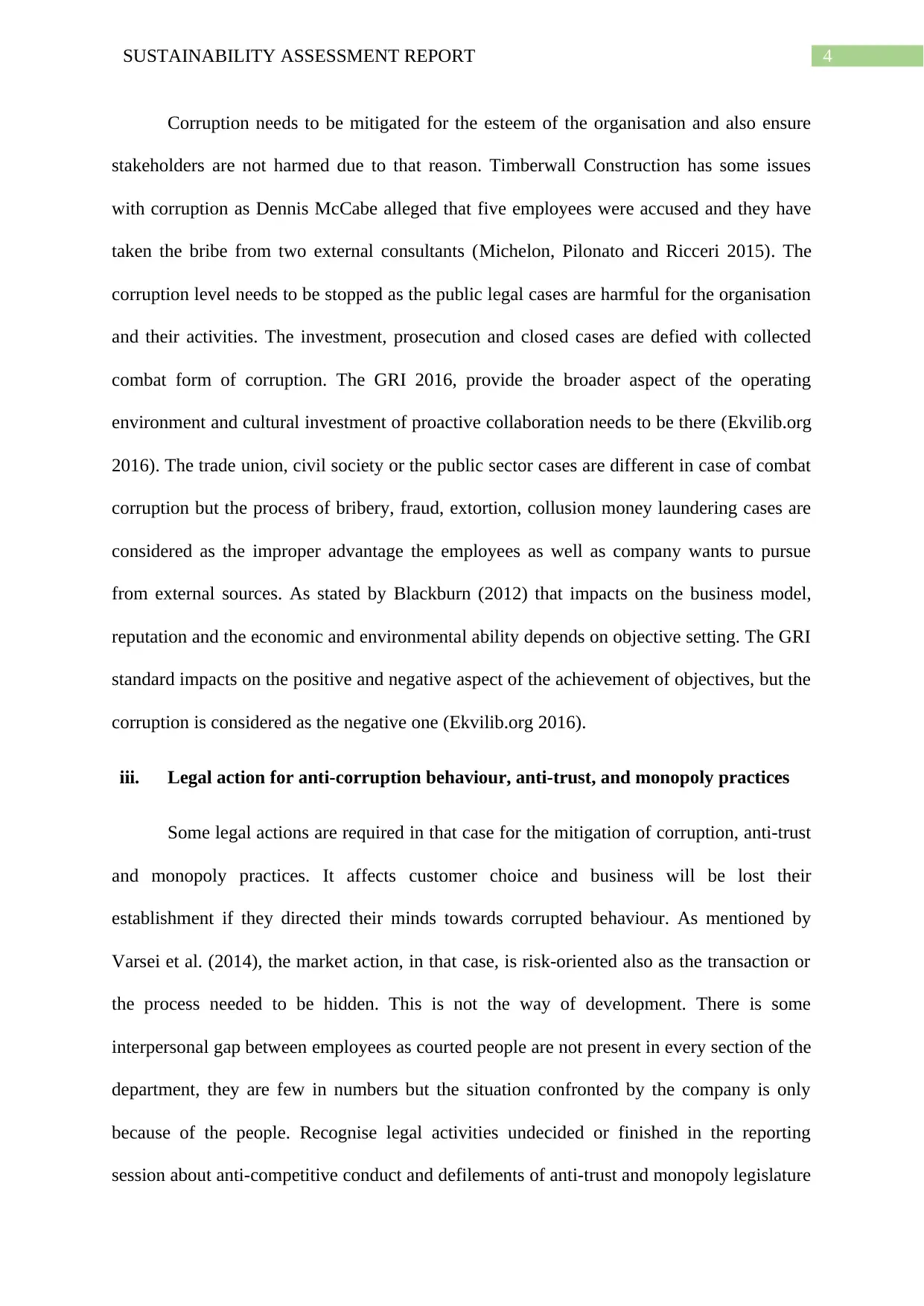
4SUSTAINABILITY ASSESSMENT REPORT
Corruption needs to be mitigated for the esteem of the organisation and also ensure
stakeholders are not harmed due to that reason. Timberwall Construction has some issues
with corruption as Dennis McCabe alleged that five employees were accused and they have
taken the bribe from two external consultants (Michelon, Pilonato and Ricceri 2015). The
corruption level needs to be stopped as the public legal cases are harmful for the organisation
and their activities. The investment, prosecution and closed cases are defied with collected
combat form of corruption. The GRI 2016, provide the broader aspect of the operating
environment and cultural investment of proactive collaboration needs to be there (Ekvilib.org
2016). The trade union, civil society or the public sector cases are different in case of combat
corruption but the process of bribery, fraud, extortion, collusion money laundering cases are
considered as the improper advantage the employees as well as company wants to pursue
from external sources. As stated by Blackburn (2012) that impacts on the business model,
reputation and the economic and environmental ability depends on objective setting. The GRI
standard impacts on the positive and negative aspect of the achievement of objectives, but the
corruption is considered as the negative one (Ekvilib.org 2016).
iii. Legal action for anti-corruption behaviour, anti-trust, and monopoly practices
Some legal actions are required in that case for the mitigation of corruption, anti-trust
and monopoly practices. It affects customer choice and business will be lost their
establishment if they directed their minds towards corrupted behaviour. As mentioned by
Varsei et al. (2014), the market action, in that case, is risk-oriented also as the transaction or
the process needed to be hidden. This is not the way of development. There is some
interpersonal gap between employees as courted people are not present in every section of the
department, they are few in numbers but the situation confronted by the company is only
because of the people. Recognise legal activities undecided or finished in the reporting
session about anti-competitive conduct and defilements of anti-trust and monopoly legislature
Corruption needs to be mitigated for the esteem of the organisation and also ensure
stakeholders are not harmed due to that reason. Timberwall Construction has some issues
with corruption as Dennis McCabe alleged that five employees were accused and they have
taken the bribe from two external consultants (Michelon, Pilonato and Ricceri 2015). The
corruption level needs to be stopped as the public legal cases are harmful for the organisation
and their activities. The investment, prosecution and closed cases are defied with collected
combat form of corruption. The GRI 2016, provide the broader aspect of the operating
environment and cultural investment of proactive collaboration needs to be there (Ekvilib.org
2016). The trade union, civil society or the public sector cases are different in case of combat
corruption but the process of bribery, fraud, extortion, collusion money laundering cases are
considered as the improper advantage the employees as well as company wants to pursue
from external sources. As stated by Blackburn (2012) that impacts on the business model,
reputation and the economic and environmental ability depends on objective setting. The GRI
standard impacts on the positive and negative aspect of the achievement of objectives, but the
corruption is considered as the negative one (Ekvilib.org 2016).
iii. Legal action for anti-corruption behaviour, anti-trust, and monopoly practices
Some legal actions are required in that case for the mitigation of corruption, anti-trust
and monopoly practices. It affects customer choice and business will be lost their
establishment if they directed their minds towards corrupted behaviour. As mentioned by
Varsei et al. (2014), the market action, in that case, is risk-oriented also as the transaction or
the process needed to be hidden. This is not the way of development. There is some
interpersonal gap between employees as courted people are not present in every section of the
department, they are few in numbers but the situation confronted by the company is only
because of the people. Recognise legal activities undecided or finished in the reporting
session about anti-competitive conduct and defilements of anti-trust and monopoly legislature
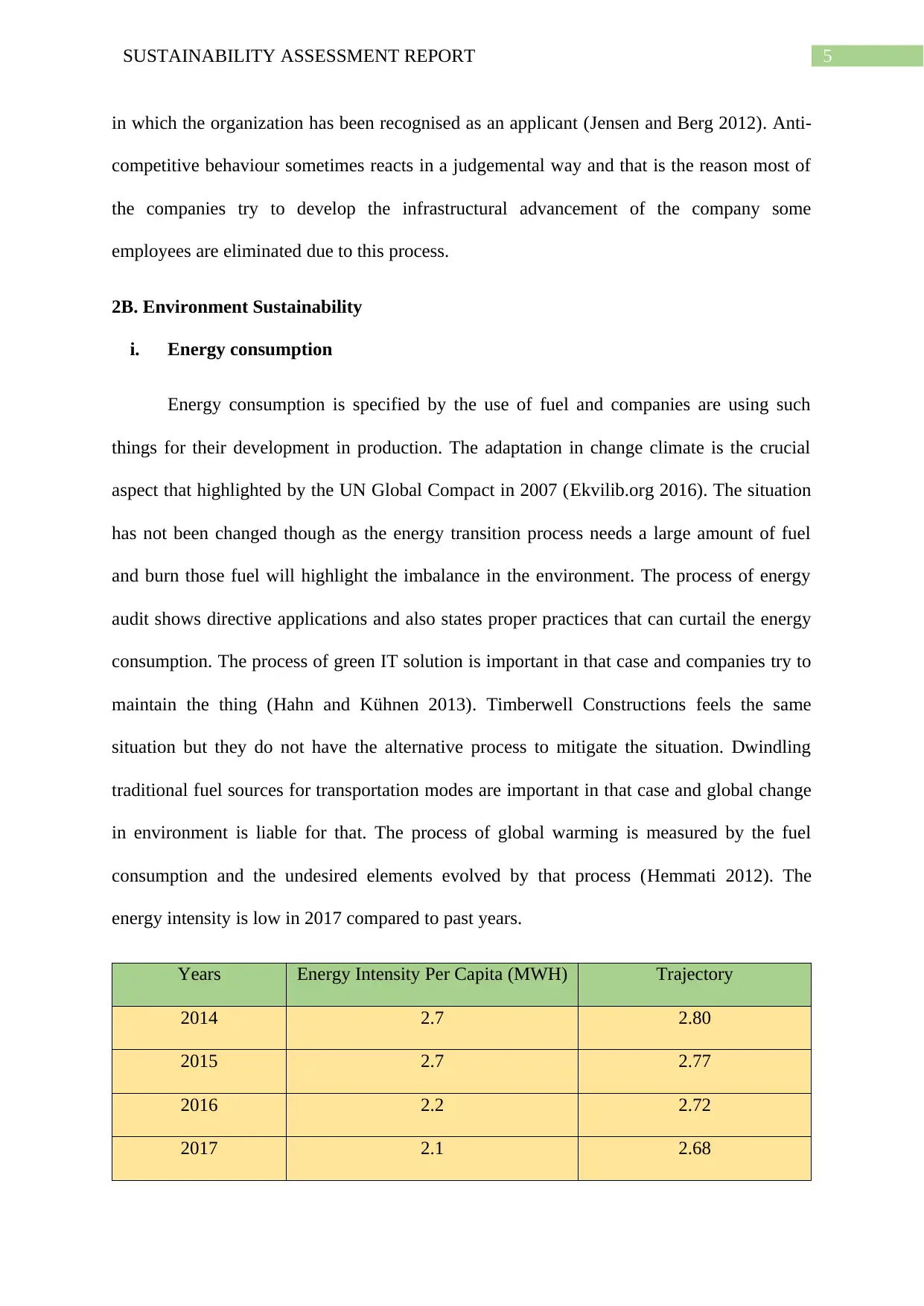
5SUSTAINABILITY ASSESSMENT REPORT
in which the organization has been recognised as an applicant (Jensen and Berg 2012). Anti-
competitive behaviour sometimes reacts in a judgemental way and that is the reason most of
the companies try to develop the infrastructural advancement of the company some
employees are eliminated due to this process.
2B. Environment Sustainability
i. Energy consumption
Energy consumption is specified by the use of fuel and companies are using such
things for their development in production. The adaptation in change climate is the crucial
aspect that highlighted by the UN Global Compact in 2007 (Ekvilib.org 2016). The situation
has not been changed though as the energy transition process needs a large amount of fuel
and burn those fuel will highlight the imbalance in the environment. The process of energy
audit shows directive applications and also states proper practices that can curtail the energy
consumption. The process of green IT solution is important in that case and companies try to
maintain the thing (Hahn and Kühnen 2013). Timberwell Constructions feels the same
situation but they do not have the alternative process to mitigate the situation. Dwindling
traditional fuel sources for transportation modes are important in that case and global change
in environment is liable for that. The process of global warming is measured by the fuel
consumption and the undesired elements evolved by that process (Hemmati 2012). The
energy intensity is low in 2017 compared to past years.
Years Energy Intensity Per Capita (MWH) Trajectory
2014 2.7 2.80
2015 2.7 2.77
2016 2.2 2.72
2017 2.1 2.68
in which the organization has been recognised as an applicant (Jensen and Berg 2012). Anti-
competitive behaviour sometimes reacts in a judgemental way and that is the reason most of
the companies try to develop the infrastructural advancement of the company some
employees are eliminated due to this process.
2B. Environment Sustainability
i. Energy consumption
Energy consumption is specified by the use of fuel and companies are using such
things for their development in production. The adaptation in change climate is the crucial
aspect that highlighted by the UN Global Compact in 2007 (Ekvilib.org 2016). The situation
has not been changed though as the energy transition process needs a large amount of fuel
and burn those fuel will highlight the imbalance in the environment. The process of energy
audit shows directive applications and also states proper practices that can curtail the energy
consumption. The process of green IT solution is important in that case and companies try to
maintain the thing (Hahn and Kühnen 2013). Timberwell Constructions feels the same
situation but they do not have the alternative process to mitigate the situation. Dwindling
traditional fuel sources for transportation modes are important in that case and global change
in environment is liable for that. The process of global warming is measured by the fuel
consumption and the undesired elements evolved by that process (Hemmati 2012). The
energy intensity is low in 2017 compared to past years.
Years Energy Intensity Per Capita (MWH) Trajectory
2014 2.7 2.80
2015 2.7 2.77
2016 2.2 2.72
2017 2.1 2.68
⊘ This is a preview!⊘
Do you want full access?
Subscribe today to unlock all pages.

Trusted by 1+ million students worldwide
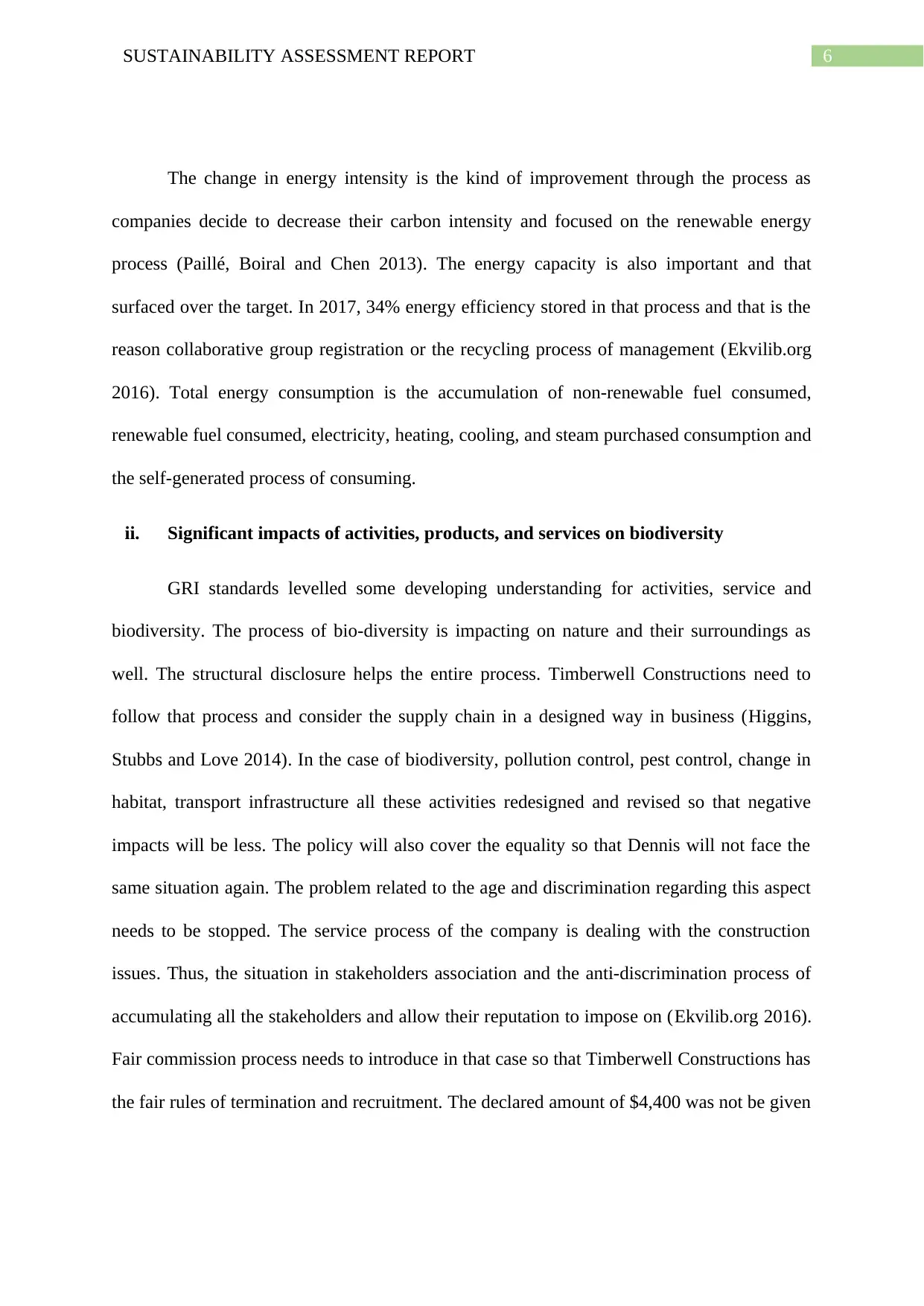
6SUSTAINABILITY ASSESSMENT REPORT
The change in energy intensity is the kind of improvement through the process as
companies decide to decrease their carbon intensity and focused on the renewable energy
process (Paillé, Boiral and Chen 2013). The energy capacity is also important and that
surfaced over the target. In 2017, 34% energy efficiency stored in that process and that is the
reason collaborative group registration or the recycling process of management (Ekvilib.org
2016). Total energy consumption is the accumulation of non-renewable fuel consumed,
renewable fuel consumed, electricity, heating, cooling, and steam purchased consumption and
the self-generated process of consuming.
ii. Significant impacts of activities, products, and services on biodiversity
GRI standards levelled some developing understanding for activities, service and
biodiversity. The process of bio-diversity is impacting on nature and their surroundings as
well. The structural disclosure helps the entire process. Timberwell Constructions need to
follow that process and consider the supply chain in a designed way in business (Higgins,
Stubbs and Love 2014). In the case of biodiversity, pollution control, pest control, change in
habitat, transport infrastructure all these activities redesigned and revised so that negative
impacts will be less. The policy will also cover the equality so that Dennis will not face the
same situation again. The problem related to the age and discrimination regarding this aspect
needs to be stopped. The service process of the company is dealing with the construction
issues. Thus, the situation in stakeholders association and the anti-discrimination process of
accumulating all the stakeholders and allow their reputation to impose on (Ekvilib.org 2016).
Fair commission process needs to introduce in that case so that Timberwell Constructions has
the fair rules of termination and recruitment. The declared amount of $4,400 was not be given
The change in energy intensity is the kind of improvement through the process as
companies decide to decrease their carbon intensity and focused on the renewable energy
process (Paillé, Boiral and Chen 2013). The energy capacity is also important and that
surfaced over the target. In 2017, 34% energy efficiency stored in that process and that is the
reason collaborative group registration or the recycling process of management (Ekvilib.org
2016). Total energy consumption is the accumulation of non-renewable fuel consumed,
renewable fuel consumed, electricity, heating, cooling, and steam purchased consumption and
the self-generated process of consuming.
ii. Significant impacts of activities, products, and services on biodiversity
GRI standards levelled some developing understanding for activities, service and
biodiversity. The process of bio-diversity is impacting on nature and their surroundings as
well. The structural disclosure helps the entire process. Timberwell Constructions need to
follow that process and consider the supply chain in a designed way in business (Higgins,
Stubbs and Love 2014). In the case of biodiversity, pollution control, pest control, change in
habitat, transport infrastructure all these activities redesigned and revised so that negative
impacts will be less. The policy will also cover the equality so that Dennis will not face the
same situation again. The problem related to the age and discrimination regarding this aspect
needs to be stopped. The service process of the company is dealing with the construction
issues. Thus, the situation in stakeholders association and the anti-discrimination process of
accumulating all the stakeholders and allow their reputation to impose on (Ekvilib.org 2016).
Fair commission process needs to introduce in that case so that Timberwell Constructions has
the fair rules of termination and recruitment. The declared amount of $4,400 was not be given
Paraphrase This Document
Need a fresh take? Get an instant paraphrase of this document with our AI Paraphraser
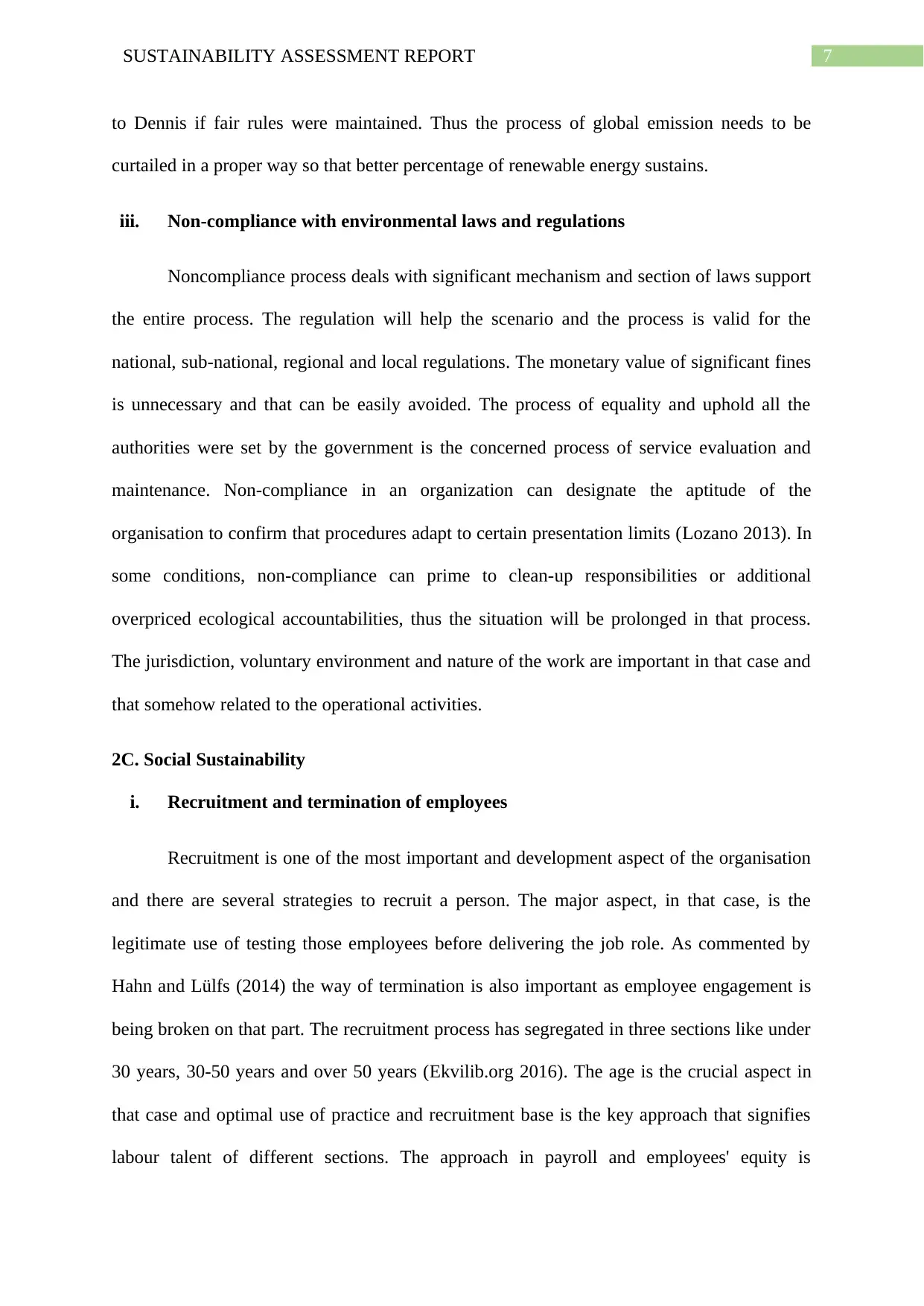
7SUSTAINABILITY ASSESSMENT REPORT
to Dennis if fair rules were maintained. Thus the process of global emission needs to be
curtailed in a proper way so that better percentage of renewable energy sustains.
iii. Non-compliance with environmental laws and regulations
Noncompliance process deals with significant mechanism and section of laws support
the entire process. The regulation will help the scenario and the process is valid for the
national, sub-national, regional and local regulations. The monetary value of significant fines
is unnecessary and that can be easily avoided. The process of equality and uphold all the
authorities were set by the government is the concerned process of service evaluation and
maintenance. Non-compliance in an organization can designate the aptitude of the
organisation to confirm that procedures adapt to certain presentation limits (Lozano 2013). In
some conditions, non-compliance can prime to clean-up responsibilities or additional
overpriced ecological accountabilities, thus the situation will be prolonged in that process.
The jurisdiction, voluntary environment and nature of the work are important in that case and
that somehow related to the operational activities.
2C. Social Sustainability
i. Recruitment and termination of employees
Recruitment is one of the most important and development aspect of the organisation
and there are several strategies to recruit a person. The major aspect, in that case, is the
legitimate use of testing those employees before delivering the job role. As commented by
Hahn and Lülfs (2014) the way of termination is also important as employee engagement is
being broken on that part. The recruitment process has segregated in three sections like under
30 years, 30-50 years and over 50 years (Ekvilib.org 2016). The age is the crucial aspect in
that case and optimal use of practice and recruitment base is the key approach that signifies
labour talent of different sections. The approach in payroll and employees' equity is
to Dennis if fair rules were maintained. Thus the process of global emission needs to be
curtailed in a proper way so that better percentage of renewable energy sustains.
iii. Non-compliance with environmental laws and regulations
Noncompliance process deals with significant mechanism and section of laws support
the entire process. The regulation will help the scenario and the process is valid for the
national, sub-national, regional and local regulations. The monetary value of significant fines
is unnecessary and that can be easily avoided. The process of equality and uphold all the
authorities were set by the government is the concerned process of service evaluation and
maintenance. Non-compliance in an organization can designate the aptitude of the
organisation to confirm that procedures adapt to certain presentation limits (Lozano 2013). In
some conditions, non-compliance can prime to clean-up responsibilities or additional
overpriced ecological accountabilities, thus the situation will be prolonged in that process.
The jurisdiction, voluntary environment and nature of the work are important in that case and
that somehow related to the operational activities.
2C. Social Sustainability
i. Recruitment and termination of employees
Recruitment is one of the most important and development aspect of the organisation
and there are several strategies to recruit a person. The major aspect, in that case, is the
legitimate use of testing those employees before delivering the job role. As commented by
Hahn and Lülfs (2014) the way of termination is also important as employee engagement is
being broken on that part. The recruitment process has segregated in three sections like under
30 years, 30-50 years and over 50 years (Ekvilib.org 2016). The age is the crucial aspect in
that case and optimal use of practice and recruitment base is the key approach that signifies
labour talent of different sections. The approach in payroll and employees' equity is
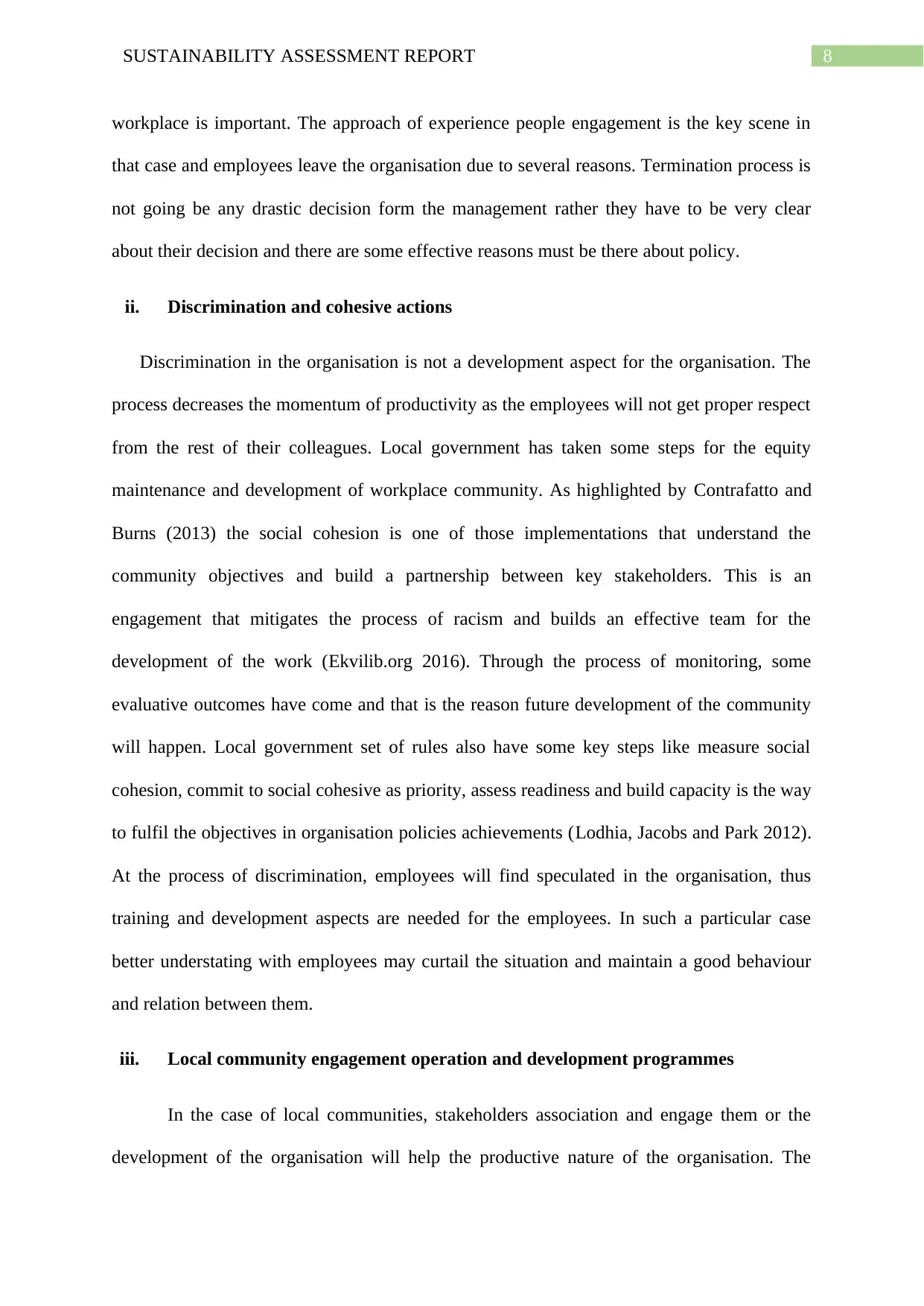
8SUSTAINABILITY ASSESSMENT REPORT
workplace is important. The approach of experience people engagement is the key scene in
that case and employees leave the organisation due to several reasons. Termination process is
not going be any drastic decision form the management rather they have to be very clear
about their decision and there are some effective reasons must be there about policy.
ii. Discrimination and cohesive actions
Discrimination in the organisation is not a development aspect for the organisation. The
process decreases the momentum of productivity as the employees will not get proper respect
from the rest of their colleagues. Local government has taken some steps for the equity
maintenance and development of workplace community. As highlighted by Contrafatto and
Burns (2013) the social cohesion is one of those implementations that understand the
community objectives and build a partnership between key stakeholders. This is an
engagement that mitigates the process of racism and builds an effective team for the
development of the work (Ekvilib.org 2016). Through the process of monitoring, some
evaluative outcomes have come and that is the reason future development of the community
will happen. Local government set of rules also have some key steps like measure social
cohesion, commit to social cohesive as priority, assess readiness and build capacity is the way
to fulfil the objectives in organisation policies achievements (Lodhia, Jacobs and Park 2012).
At the process of discrimination, employees will find speculated in the organisation, thus
training and development aspects are needed for the employees. In such a particular case
better understating with employees may curtail the situation and maintain a good behaviour
and relation between them.
iii. Local community engagement operation and development programmes
In the case of local communities, stakeholders association and engage them or the
development of the organisation will help the productive nature of the organisation. The
workplace is important. The approach of experience people engagement is the key scene in
that case and employees leave the organisation due to several reasons. Termination process is
not going be any drastic decision form the management rather they have to be very clear
about their decision and there are some effective reasons must be there about policy.
ii. Discrimination and cohesive actions
Discrimination in the organisation is not a development aspect for the organisation. The
process decreases the momentum of productivity as the employees will not get proper respect
from the rest of their colleagues. Local government has taken some steps for the equity
maintenance and development of workplace community. As highlighted by Contrafatto and
Burns (2013) the social cohesion is one of those implementations that understand the
community objectives and build a partnership between key stakeholders. This is an
engagement that mitigates the process of racism and builds an effective team for the
development of the work (Ekvilib.org 2016). Through the process of monitoring, some
evaluative outcomes have come and that is the reason future development of the community
will happen. Local government set of rules also have some key steps like measure social
cohesion, commit to social cohesive as priority, assess readiness and build capacity is the way
to fulfil the objectives in organisation policies achievements (Lodhia, Jacobs and Park 2012).
At the process of discrimination, employees will find speculated in the organisation, thus
training and development aspects are needed for the employees. In such a particular case
better understating with employees may curtail the situation and maintain a good behaviour
and relation between them.
iii. Local community engagement operation and development programmes
In the case of local communities, stakeholders association and engage them or the
development of the organisation will help the productive nature of the organisation. The
⊘ This is a preview!⊘
Do you want full access?
Subscribe today to unlock all pages.

Trusted by 1+ million students worldwide
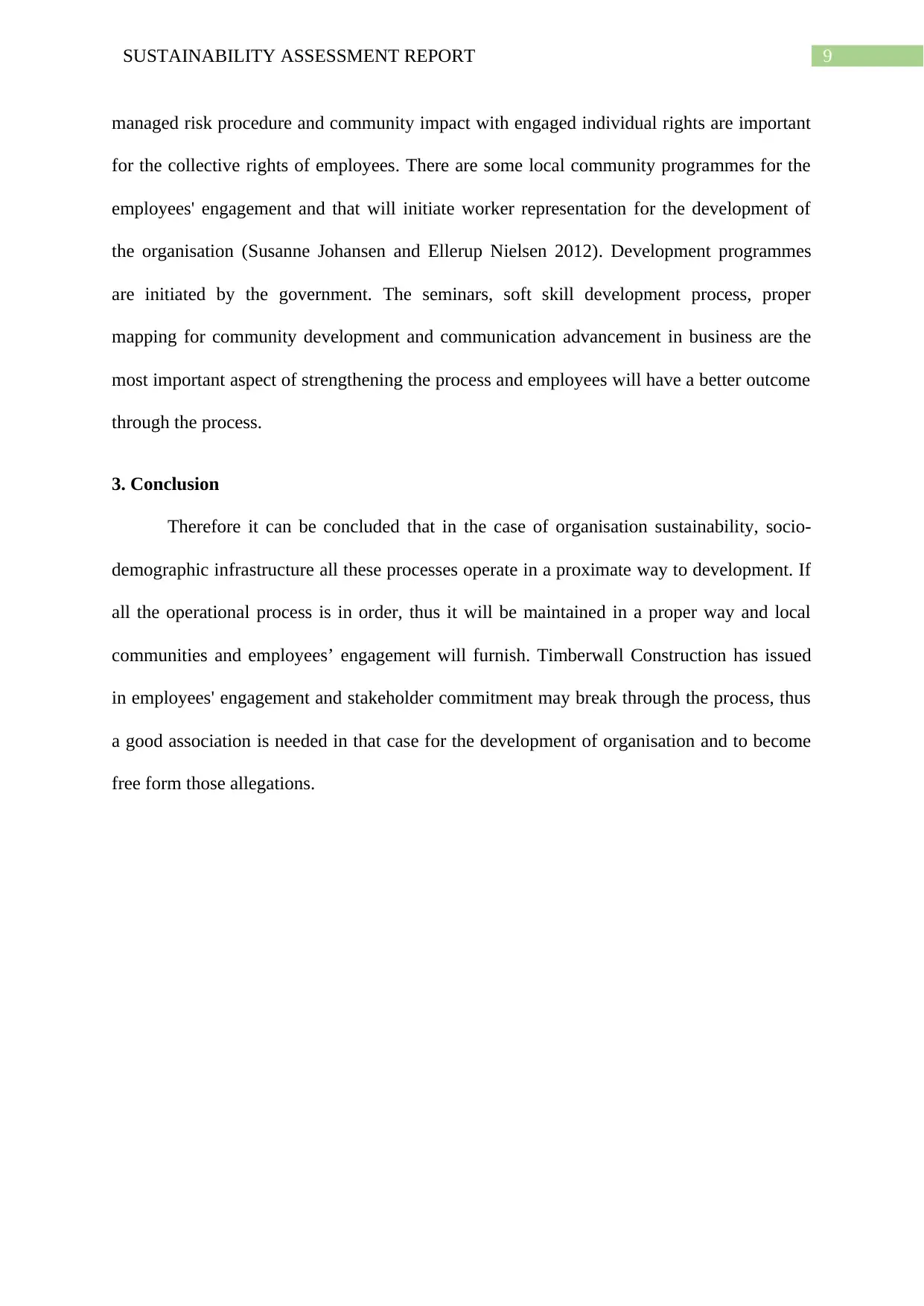
9SUSTAINABILITY ASSESSMENT REPORT
managed risk procedure and community impact with engaged individual rights are important
for the collective rights of employees. There are some local community programmes for the
employees' engagement and that will initiate worker representation for the development of
the organisation (Susanne Johansen and Ellerup Nielsen 2012). Development programmes
are initiated by the government. The seminars, soft skill development process, proper
mapping for community development and communication advancement in business are the
most important aspect of strengthening the process and employees will have a better outcome
through the process.
3. Conclusion
Therefore it can be concluded that in the case of organisation sustainability, socio-
demographic infrastructure all these processes operate in a proximate way to development. If
all the operational process is in order, thus it will be maintained in a proper way and local
communities and employees’ engagement will furnish. Timberwall Construction has issued
in employees' engagement and stakeholder commitment may break through the process, thus
a good association is needed in that case for the development of organisation and to become
free form those allegations.
managed risk procedure and community impact with engaged individual rights are important
for the collective rights of employees. There are some local community programmes for the
employees' engagement and that will initiate worker representation for the development of
the organisation (Susanne Johansen and Ellerup Nielsen 2012). Development programmes
are initiated by the government. The seminars, soft skill development process, proper
mapping for community development and communication advancement in business are the
most important aspect of strengthening the process and employees will have a better outcome
through the process.
3. Conclusion
Therefore it can be concluded that in the case of organisation sustainability, socio-
demographic infrastructure all these processes operate in a proximate way to development. If
all the operational process is in order, thus it will be maintained in a proper way and local
communities and employees’ engagement will furnish. Timberwall Construction has issued
in employees' engagement and stakeholder commitment may break through the process, thus
a good association is needed in that case for the development of organisation and to become
free form those allegations.
Paraphrase This Document
Need a fresh take? Get an instant paraphrase of this document with our AI Paraphraser
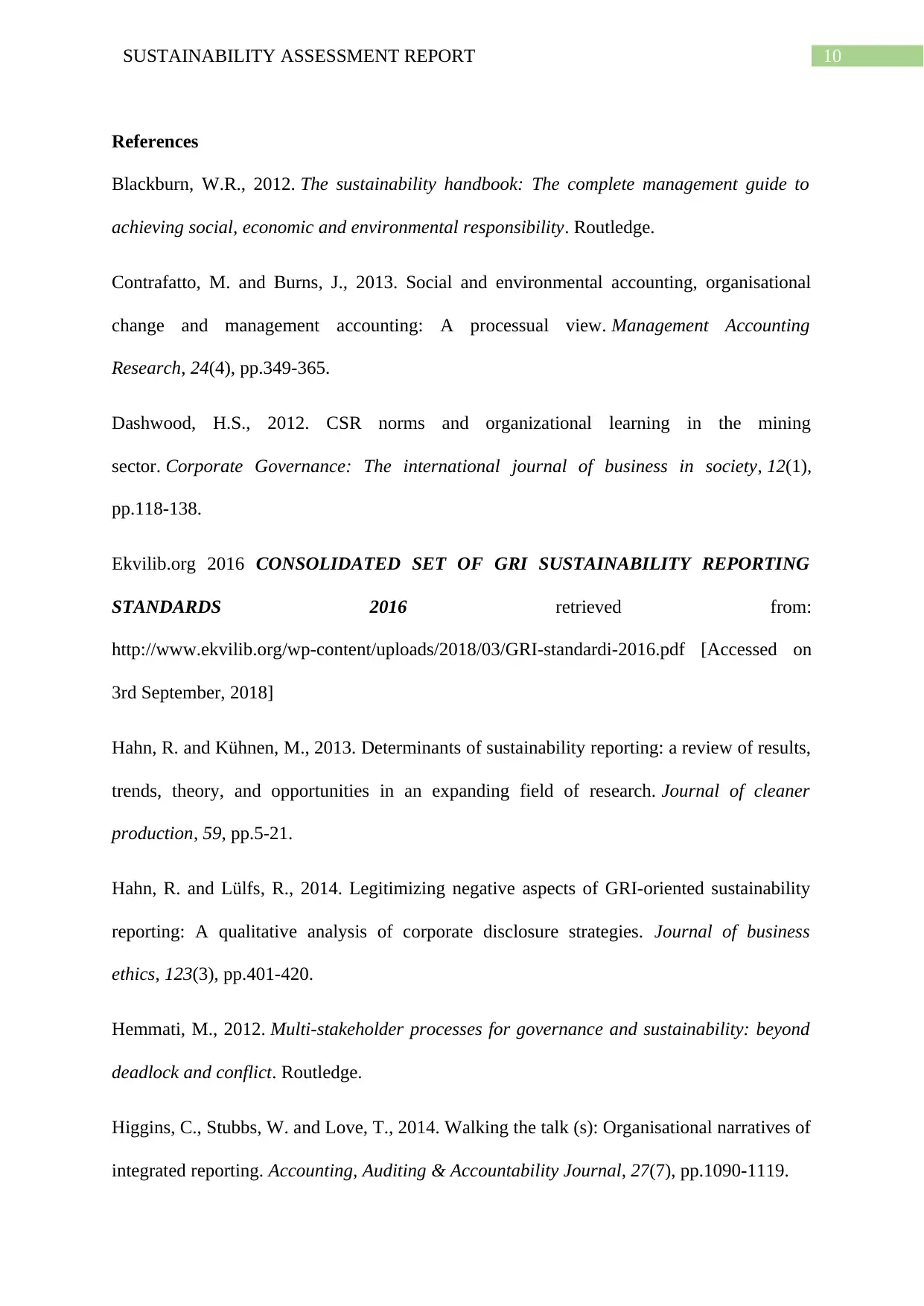
10SUSTAINABILITY ASSESSMENT REPORT
References
Blackburn, W.R., 2012. The sustainability handbook: The complete management guide to
achieving social, economic and environmental responsibility. Routledge.
Contrafatto, M. and Burns, J., 2013. Social and environmental accounting, organisational
change and management accounting: A processual view. Management Accounting
Research, 24(4), pp.349-365.
Dashwood, H.S., 2012. CSR norms and organizational learning in the mining
sector. Corporate Governance: The international journal of business in society, 12(1),
pp.118-138.
Ekvilib.org 2016 CONSOLIDATED SET OF GRI SUSTAINABILITY REPORTING
STANDARDS 2016 retrieved from:
http://www.ekvilib.org/wp-content/uploads/2018/03/GRI-standardi-2016.pdf [Accessed on
3rd September, 2018]
Hahn, R. and Kühnen, M., 2013. Determinants of sustainability reporting: a review of results,
trends, theory, and opportunities in an expanding field of research. Journal of cleaner
production, 59, pp.5-21.
Hahn, R. and Lülfs, R., 2014. Legitimizing negative aspects of GRI-oriented sustainability
reporting: A qualitative analysis of corporate disclosure strategies. Journal of business
ethics, 123(3), pp.401-420.
Hemmati, M., 2012. Multi-stakeholder processes for governance and sustainability: beyond
deadlock and conflict. Routledge.
Higgins, C., Stubbs, W. and Love, T., 2014. Walking the talk (s): Organisational narratives of
integrated reporting. Accounting, Auditing & Accountability Journal, 27(7), pp.1090-1119.
References
Blackburn, W.R., 2012. The sustainability handbook: The complete management guide to
achieving social, economic and environmental responsibility. Routledge.
Contrafatto, M. and Burns, J., 2013. Social and environmental accounting, organisational
change and management accounting: A processual view. Management Accounting
Research, 24(4), pp.349-365.
Dashwood, H.S., 2012. CSR norms and organizational learning in the mining
sector. Corporate Governance: The international journal of business in society, 12(1),
pp.118-138.
Ekvilib.org 2016 CONSOLIDATED SET OF GRI SUSTAINABILITY REPORTING
STANDARDS 2016 retrieved from:
http://www.ekvilib.org/wp-content/uploads/2018/03/GRI-standardi-2016.pdf [Accessed on
3rd September, 2018]
Hahn, R. and Kühnen, M., 2013. Determinants of sustainability reporting: a review of results,
trends, theory, and opportunities in an expanding field of research. Journal of cleaner
production, 59, pp.5-21.
Hahn, R. and Lülfs, R., 2014. Legitimizing negative aspects of GRI-oriented sustainability
reporting: A qualitative analysis of corporate disclosure strategies. Journal of business
ethics, 123(3), pp.401-420.
Hemmati, M., 2012. Multi-stakeholder processes for governance and sustainability: beyond
deadlock and conflict. Routledge.
Higgins, C., Stubbs, W. and Love, T., 2014. Walking the talk (s): Organisational narratives of
integrated reporting. Accounting, Auditing & Accountability Journal, 27(7), pp.1090-1119.
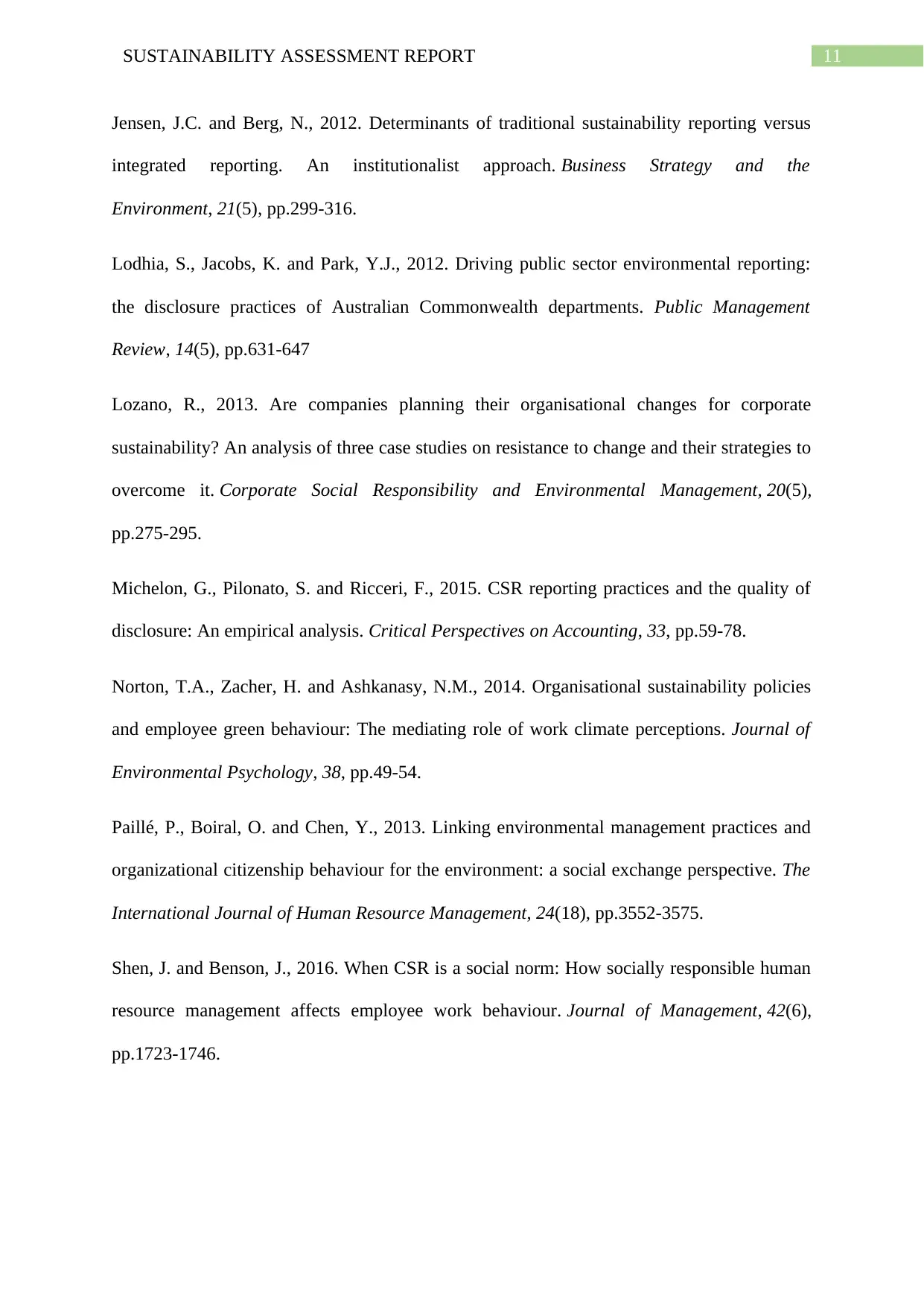
11SUSTAINABILITY ASSESSMENT REPORT
Jensen, J.C. and Berg, N., 2012. Determinants of traditional sustainability reporting versus
integrated reporting. An institutionalist approach. Business Strategy and the
Environment, 21(5), pp.299-316.
Lodhia, S., Jacobs, K. and Park, Y.J., 2012. Driving public sector environmental reporting:
the disclosure practices of Australian Commonwealth departments. Public Management
Review, 14(5), pp.631-647
Lozano, R., 2013. Are companies planning their organisational changes for corporate
sustainability? An analysis of three case studies on resistance to change and their strategies to
overcome it. Corporate Social Responsibility and Environmental Management, 20(5),
pp.275-295.
Michelon, G., Pilonato, S. and Ricceri, F., 2015. CSR reporting practices and the quality of
disclosure: An empirical analysis. Critical Perspectives on Accounting, 33, pp.59-78.
Norton, T.A., Zacher, H. and Ashkanasy, N.M., 2014. Organisational sustainability policies
and employee green behaviour: The mediating role of work climate perceptions. Journal of
Environmental Psychology, 38, pp.49-54.
Paillé, P., Boiral, O. and Chen, Y., 2013. Linking environmental management practices and
organizational citizenship behaviour for the environment: a social exchange perspective. The
International Journal of Human Resource Management, 24(18), pp.3552-3575.
Shen, J. and Benson, J., 2016. When CSR is a social norm: How socially responsible human
resource management affects employee work behaviour. Journal of Management, 42(6),
pp.1723-1746.
Jensen, J.C. and Berg, N., 2012. Determinants of traditional sustainability reporting versus
integrated reporting. An institutionalist approach. Business Strategy and the
Environment, 21(5), pp.299-316.
Lodhia, S., Jacobs, K. and Park, Y.J., 2012. Driving public sector environmental reporting:
the disclosure practices of Australian Commonwealth departments. Public Management
Review, 14(5), pp.631-647
Lozano, R., 2013. Are companies planning their organisational changes for corporate
sustainability? An analysis of three case studies on resistance to change and their strategies to
overcome it. Corporate Social Responsibility and Environmental Management, 20(5),
pp.275-295.
Michelon, G., Pilonato, S. and Ricceri, F., 2015. CSR reporting practices and the quality of
disclosure: An empirical analysis. Critical Perspectives on Accounting, 33, pp.59-78.
Norton, T.A., Zacher, H. and Ashkanasy, N.M., 2014. Organisational sustainability policies
and employee green behaviour: The mediating role of work climate perceptions. Journal of
Environmental Psychology, 38, pp.49-54.
Paillé, P., Boiral, O. and Chen, Y., 2013. Linking environmental management practices and
organizational citizenship behaviour for the environment: a social exchange perspective. The
International Journal of Human Resource Management, 24(18), pp.3552-3575.
Shen, J. and Benson, J., 2016. When CSR is a social norm: How socially responsible human
resource management affects employee work behaviour. Journal of Management, 42(6),
pp.1723-1746.
⊘ This is a preview!⊘
Do you want full access?
Subscribe today to unlock all pages.

Trusted by 1+ million students worldwide
1 out of 13
Related Documents
Your All-in-One AI-Powered Toolkit for Academic Success.
+13062052269
info@desklib.com
Available 24*7 on WhatsApp / Email
![[object Object]](/_next/static/media/star-bottom.7253800d.svg)
Unlock your academic potential
Copyright © 2020–2025 A2Z Services. All Rights Reserved. Developed and managed by ZUCOL.





